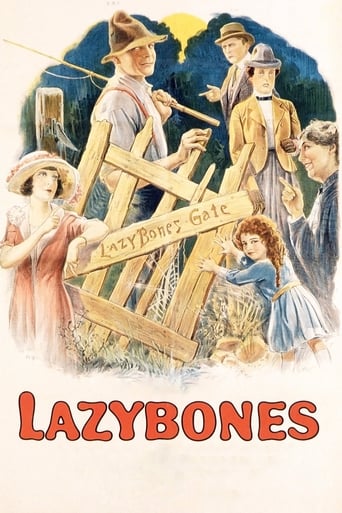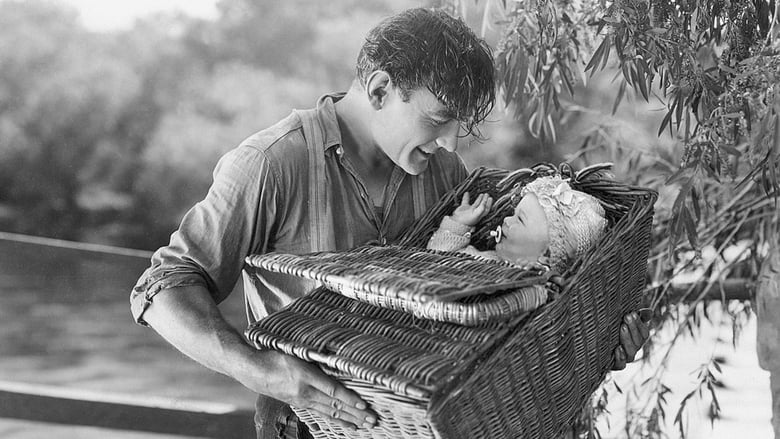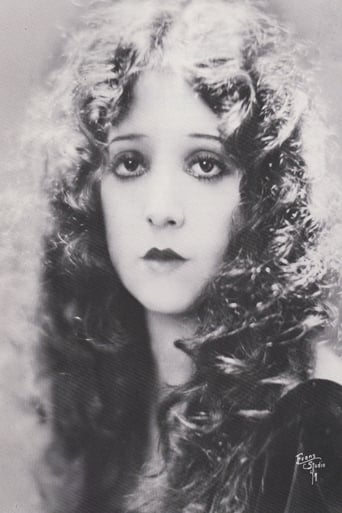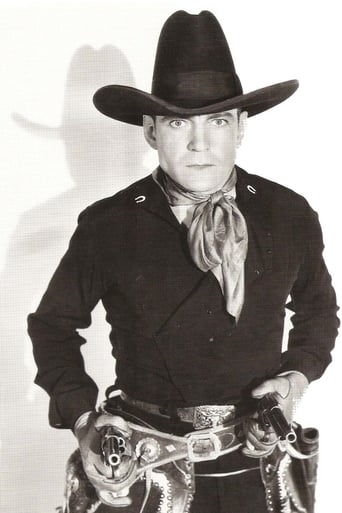

Lazybones (1925)
Steve Tuttle, the titular lazybones, takes on the responsibility of raising a fatherless girl, causing a scandal in his small town. Many years later, having returned from World War I, he discovers that he loves the grown-up girl.
Watch Trailer
Cast


Reviews
You won't be disappointed!
Powerful
Bad Acting and worse Bad Screenplay
The biggest problem with this movie is it’s a little better than you think it might be, which somehow makes it worse. As in, it takes itself a bit too seriously, which makes most of the movie feel kind of dull.
The title character, Lazybones (Buck Jones), was named this because he's a ridiculous caricature when it comes to his sleeping all the time and being incredibly lazy. I didn't like this concept, as it just seemed very unreal. However, I did love his character later in the film when he showed he was more than just a one-dimensional guy. While fishing, he sees a woman trying to drown herself in the river (Zasu Pitts). It seems she's feeling desperate--she married a sailor who has since died and she's now stuck with his baby. Her family doesn't know and she anticipates that her nasty mother will reject her and the kid (in an 'I told you so' moment)--hence she threw herself in the river. Lazybones takes pity on her and agrees to take the kid home and raise it himself agrees never to tell anyone who the real mother is. Time passes and the child grows up in a nasty town where the other kids enjoy tormenting her because of her lowly birth. But despite this, she is a nice kid and grows to be a lovely woman. However, Lazybones doesn't see this transformation, as he's off in the war and when he returns he sees her in all her glory. He almost instantly falls in love with her (which is icky considering that he raised her) and plans on asking for her to marry him. But another man, much younger, has already won her heart and nice 'ol Lazybones is left with his unrequited love.The film is very lovingly filmed and the director (Frank Borzage) did a great job with the material. The acting, likewise, was quite good. I just couldn't get past how one-dimensional some of the characters seemed (not just Lazybones but Pitts' mother) as well as the creepy notion of a guy wanting to marry a girl he raised. Still, it is a nice little film...if a bit odd.
Buck Jones is a huge surprise in this 1925 silent, playing a rural man who lives with his mother (Edythe Chapman) and is known as Lazybones. Frank Borzage's delicate film (beautifully shot) shows the true of a man no one really knows. He sits around and fishes, neglecting chores and a local girl (Jane Novak) who is in love with him, much to the relief of her battle-axe mother (Emily Fitzroy).The one day, her sister (Zasu Pitts) returns from the city, where she was married to a sailor who has been lost at sea. She also has a baby. Knowing that no one in small-town America will believe she had been married, she sets down the baby and jumps into the river. Lazybones sees her and jumps in to save her. She tells him her story and they concoct a plan whereby he will claim to have found the baby and she can return home alone in a few days.Of course the town turns on him and the baby girl, but Lazybones holds to his promise while Pitts is consigned to marry a local jerk. Even the sister turns on Lazybones and says she'll never speak to him again. The years pass.As World War I approached, Lazybones goes off the war while the baby Kit (Madge Bellamy) is now about 15. Lazybones inadvertently becomes a war hero and returns to a town that has still never quite forgiven him. Kit now has a boyfriend (Leslie Fenton). Lazybones realizes he is in love with Kit and just as quickly realizes how many of their lives have changed over the years.Jones is terrific. He usually starred in Westerns and for a time rivaled William S. Hart in popularity. Here he has a chance at a part that requires a delicate mix of drama and comedy. Zasu Pitts is fantastic as the tragic Ruth. Best know for her fluttery old maids, here she turns in a solid dramatic performance. Also good are Bellamy, Novak, and Chapman. A special word is needed for Fitzroy, who along with Josephine Crowell, ranks among the major battle-axes of the silent era.A final word on Buck Jones. He was still going strong in 1942, starring in B Westerns when he was caught in the famous Coconut Grove fire in Boston. He died two days later.
My first entry in the sudden Borzage/Murnau double-quest I've been thrust into by receiving the behemoth collection that bears their names was this forgotten 1925 melodrama with the title that sounds like a slapstick comedy: Frank Borzage's Lazybones.The film concerns a dude named Steve (Buck Jones) that just lays around all the time, and his one activity is fishing, which involves him laying around all the time. Needless to say, he has acquired the nickname "Lazybones". He's sweet on a girl named Agnes (Jane Novak), whose evil mother (Emily Fitzroy) forbids her to go with him, and has arranged a marriage for her abroad student daughter Ruth (Zasu Pitts) with "the local Beau Brummel", Elmer Ballister (William Bailey). But while doin' jacksh-t, Steve runs into Ruth upon her return, with an infant and a story: she married a seaman in secret because she knew her mother wouldn't approve, she had a child, and then he went off to sea, never to return. Steve offers to claim he found the baby in the reeds until Ruth's ready to tell her mother, but when Ruth's mother whips her and threatens to send the child away if Ruth tells anyone, Steve ends up keeping her and raising her himself. From there, the film fast-forwards episodically to the child, named Kit (Virginia Marshall, later Madge Bellamy) as a young girl, as a teenager, and as a young woman in 1917, and Steve finally has to do something, and gets shipped off to war.The film is a fairly dour affair all around, no one is content, no one is satisfied, no one is happy, and it pretty much stays that way. Their one recurring gag, how every single person that enter's Steve's house, from grandmother on down to adopted daughter, runs into the stubborn gate and yells, "Darn that gate!", isn't really that funny, but it's one of the few moments of lightheartedness in the entire piece, and even then, it's used as a heartbreaking mile-marker motif later in the film when he gets sent off to war. Actually, one into the trenches of Europe, the film turns to outright slapstick as through dumb luck, he becomes a national hero.But the film takes a weird turn once he returns home from the war that made me sort of lose all sympathy for Steve and sort of soured the dramatic weight of the film: he falls in love with his adopted daughter. Despite the fact that he has raised this girl from the time she was still forming kneecaps, and he has been her singular parental guardian, and yet we're supposed to feel sad when he comes back for war and wants to do things that, had they been related, would have been illegal and are taboo to depict, even now? No thanks. I'm glad this collection is mostly Borzage (only two of the twelve films in the collection are from Murnau), because of the two I've seen (this and Moonrise, I've been pretty much underwhelmed.{Grade: 6/10 (C+) / #6 (of 6) of 1925}
My fellow reviewers have done so much justice to this fine film that I hesitated to submit my own thoughts, since many of them would be quite redundant. I therefore will not comment so much on the story itself in this review, but instead concentrate on some of the aesthetic qualities of the film.The careful attention to period detail is one of the salient features of LAZYBONES. Produced in 1925, but telling a story that reaches back to the turn-of-the-century and advances to "now," it genuinely captures the look of each era it portrays. Often films made in the 1920s but set, say, before the War (WWI), look very different from actual films produced in 1914 -- we can see it in the clothes and the hairstyles. In LAZYBONES this is not the case. Even the characters age believably as the decades advance (only Kit is portrayed by different actresses as she grows up). Buck Jones's transformation from a teenager to an almost middle-aged man is especially noteworthy.Another strength of Borzage's direction is his strong evocation of place. His rural America is steeped in romanticism -- so stylized and yet so personal as to exist both everywhere and nowhere simultaneously. One is left with the feeling that these characters -- especially Steve (Buck Jones) and his mother (Edythe Chapman) -- are inextricably linked with the languid atmosphere of their environment. This quality is also reflected in Borzage's lingering, empathetic close-ups that seem to stretch time beyond its natural bounds. The scene in which Ruth (Zasu Pitts) passes by Steve's house in the carriage, catching a glimpse of her daughter, is one such example. This moment -- consisting of only a few seconds in real time -- is frozen as Borzage focuses on the emotions displayed in the expressions of Ruth, Steve, and Kit (Virginia Marshall). The reunion scene when Steve returns from the war is certainly every bit the equal of the one near the end of Vidor's THE BIG PARADE, and is another prime example of "stretching time" for dramatic effect.In contrast to such Borzage silent masterpieces as 7TH HEAVEN, STREET ANGEL, and LUCKY STAR, I would classify LAZYBONES as a film fundamentally grounded in realism (note the prominent use of real exteriors instead of studio back-lot sets). At the same time, however, Borzage flavors the whole work with a wistful romanticism that is never cloying but somehow manages to capture the dream-like qualities of our own nostalgic memories: snapshot moments, tinged at times with melancholy, at times with happiness.




